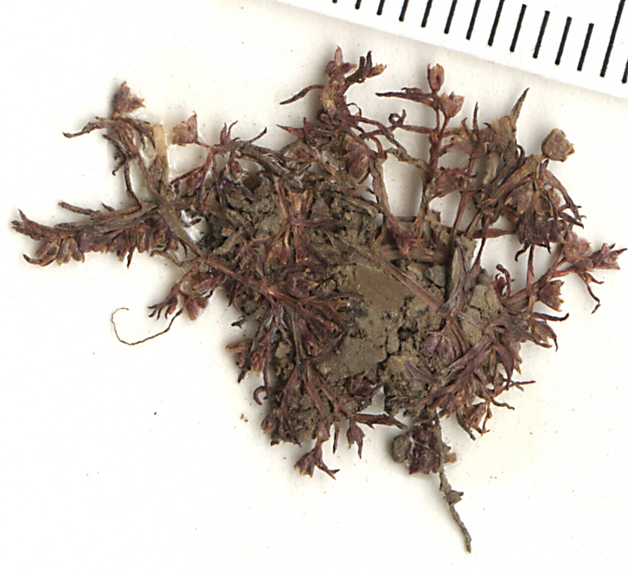
|
Crassulaceae |
|
|
Annual, biennial, or perennial herbs or shrubs [rarely scandent], succulent. Stems mostly alike and all potentially flowering, (flowering stems annual, axillary, overtopping primary stem). Leaves usually persistent, sometimes deciduous or caducous, cauline or sometimes in dense basal rosettes, alternate, opposite, or whorled, simple (pinnate in Bryophyllum), (heteromorphic in Dudleya, Echeveria, Graptopetalum); stipules absent; petiole usually absent; blade margins usually entire, sometimes toothed or lobed. Inflorescences terminal or axillary, spikes, thyrses, or mostly cymes, branches commonly cincinni (scorpioid cymes) and at first commonly coiled, or rarely flowers solitary. Flowers bisexual (sometimes unisexual in Rhodiola), radially symmetric (except sometimes calyx); perianth and androecium hypogynous or weakly perigynous; hypanthium present; sepals (3-)4-5(-12)[-30+], distinct or connate basally (or into tube); petals (3-)4-5(-12)[-30+], distinct or connate basally or sometimes into tube, margins entire (fimbrillate in Jovibarba, crenate in Phedimus); nectaries as scales at base of carpels; stamens as many as sepals or 2 times as many and in 2 series, antipetalous if in 1 series, free or adnate to corolla base (or tube); anthers dehiscent longitudinally and laterally; pistils (3-)4-5(-12)[-30+] [rarely fewer than sepals], mostly distinct or nearly so, (3-)4-5(-12)[-30+]-carpellate; ovary superior or semi-inferior, 1-locular; placentation submarginal; ovules anatropous, bitegmic, crassinucellate or tenuinucellate; styles (3-)4-5(-12)[-30+], terminal, distinct; stigmas (3-) 4-5(-12)[-30], terminal, capitate. Fruits usually whorls of follicles, each dehiscent along adaxial suture, rarely whorls of flimsy 1-seeded utricles (Sedella) or capsules of basally connate pistils (Diamorpha, Jovibarba). Seeds 1-20+ per carpel, brownish, fusiform or ellipsoid; embryo straight; endosperm oily, scant. Phylogenetic analyses (M. W. Chase et al. 1993; D. R. Morgan and D. E. Soltis 1993; D. E. Soltis and P. S. Soltis 1997; D. E. Soltis et al. 1997; M. E. Mort et al. 2001) confirm that Crassulaceae are monophyletic and place them in a Saxifragales clade. They are close to Saxifragaceae but differ in their predominantly succulent habit, their numerically regular flowers with the same number of sepals, petals, and pistils and as many or twice as many stamens, their separate nectaries, one at the base of each pistil, their mostly separate pistils, and their seeds with little or no endosperm. The only genus of questionable position has been Penthorum Linnaeus, sometimes placed here but clearly discordant. On the basis of embryology, J. Mauritzon (1933) found it closer to Saxifragaceae. From the anatomy, M. L. Haskins and W. J. Hayden (1987) thought it distinct from both and probably best kept as a separate family, Penthoraceae, as here. Podostemaceae also are thought related to Crassulaceae, although these submerged aquatics are so different and distinct that there are no intermediates. In this family, as J. D. Hooker (1865) remarked, genera are poorly defined, and there has been much disagreement about them. Recent and continuing chemical and chloroplast-DNA studies by H. ´t Hart and associates (e.g., H. ´t Hart 1995) are shedding light on relationships and will continue to influence delimitation of genera, although thus far they are based on far too few American plants. U. Knapp´s (1994) seed studies also are helpful.
PLANT: Succulent annual or perennial plants, ours herbaceous and papillose or mostly glabrous. LEAVES: opposite or alternate, without stipules, in ours sessile, simple, mostly entire, sometimes in dense rosettes. INFLORESCENCE: mostly cymes, the branches commonly one-sided, zigzag, at first coiled; or flowers solitary. FLOWERS: actinomorphic or nearly so, 3-many-merous, commonly 5-merous, in ours perfect; sepals in ours separate or nearly so; petals as many as sepals, separate or united; stamens as many as sepals or twice as many, free or on corolla base; pistils as many as sepals, mostly separate or nearly so, each with nectar gland at base. FRUIT: of follicles, each with one to many tiny seeds. NOTES: Ca. 40 genera and 1500 spp., mostly of n temperate regions and s Afr. Many ornamentals and a few minor medicinal plants. REFERENCES: Moran, Reid. 1994. Bixaceae. J. Ariz. - Nev. Acad. Sci. Volume 27, 190-194. |
|


